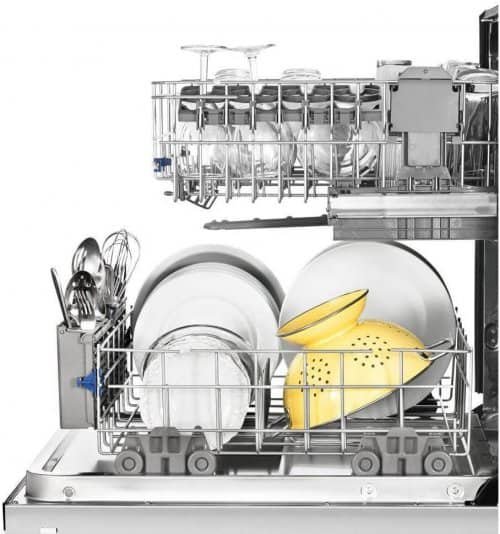Dishwashers are a fantastic addition to any kitchen, providing a convenient and efficient way to clean dishes, glasses, and cutlery. They are designed to make our lives easier, but sometimes things can go wrong. One common problem that people encounter is accidentally putting dish soap in the rinse aid compartment. This can cause an excessive amount of suds, which can lead to leaks, damage to the dishwasher, and poor cleaning results. In this article, we will discuss how to get dish soap out of the dishwasher rinse aid compartment.
Table of Contents
What is Rinse Aid?
Rinse aid is a detergent additive that is used in dishwashers to enhance the cleaning process. It is usually dispensed during the final rinse cycle and helps to remove any remaining food particles, grease, or soap residue from dishes. Rinse aid also helps to prevent water spots, streaks, and hazy film from forming on glassware and other dishes. It is an essential component of the dishwasher cleaning process and can improve the performance of your dishwasher.
What Happens When You Put Dish Soap in the Rinse Aid Compartment?
If you accidentally put dish soap in the rinse aid compartment, you may notice an excessive amount of suds during the wash cycle. This is because dish soap is designed to create suds and bubbles, which can cause problems when it comes into contact with the rinse aid. The excess suds can overflow from the dishwasher, causing a mess in your kitchen. The soap suds can also damage the dishwasher’s mechanical components, including the pump and motor.
Steps to Remove Dish Soap from the Rinse Aid Compartment
If you have accidentally put dish soap in the rinse aid compartment, don’t panic. There are several steps you can take to remove the soap and prevent damage to your dishwasher. Here are some tips to help you remove dish soap from the rinse aid compartment:
- Turn off the Dishwasher: The first thing you should do is turn off the dishwasher. This will prevent the soap suds from getting worse and causing more damage.
- Remove the Rinse Aid Dispenser: The next step is to remove the rinse aid dispenser from the dishwasher. You can usually do this by pressing a button or turning a knob. Consult your dishwasher’s manual if you are unsure how to do this.
- Empty the Rinse Aid Compartment: Once you have removed the dispenser, empty the rinse aid compartment. You can do this by tipping the dispenser over and pouring out the soap.
- Rinse the Dispenser: After you have emptied the rinse aid compartment, rinse the dispenser thoroughly with warm water. This will help to remove any soap residue.
- Refill the Rinse Aid Compartment: Once you have rinsed the dispenser, refill the rinse aid compartment with the correct rinse aid. Be sure to follow the manufacturer’s instructions for the correct amount of rinse aid to use.
- Run a Rinse Cycle: After you have refilled the rinse aid compartment, run a rinse cycle to flush out any remaining soap suds.
- Inspect the Dishwasher: After the rinse cycle has finished, inspect the dishwasher for any remaining soap suds. If you notice any suds, repeat the rinse cycle until the dishwasher is free of soap suds.

Preventing Future Mishaps
Accidentally putting dish soap in the rinse aid compartment is a common mistake, but there are several steps you can take to prevent it from happening again. Here are some tips to help you prevent future mishaps:
- Label the Dispensers: To avoid confusion, label the rinse aid and detergent dispensers with clear and easy-to-read labels. This will help you and others in your household to avoid mixing up the two.
- Use the Correct Products: Make sure you use the correct products when loading the dishwasher. Check the labels on the products to ensure that you are using the correct detergent and rinse aid. Using the wrong products can result in poor cleaning results, damage to the dishwasher, and excessive suds.
- Measure the Detergent: Use the correct amount of detergent for the load size and water hardness level. Too much detergent can result in excessive suds, and too little can result in poor cleaning results. Follow the manufacturer’s instructions for the correct amount of detergent to use.
- Check the Dispensers: Before starting the dishwasher, check the detergent and rinse aid dispensers to ensure that they are empty. This will prevent any accidental mixing of the two products.
- Clean the Dispensers: Regularly clean the detergent and rinse aid dispensers to prevent any buildup or clogs. Follow the manufacturer’s instructions for cleaning the dispensers.
Conclusion
Accidentally putting dish soap in the rinse aid compartment is a common mistake, but it can be easily fixed by following the steps outlined above. Remember to turn off the dishwasher, remove the rinse aid dispenser, empty the compartment, rinse the dispenser, refill the compartment, run a rinse cycle, and inspect the dishwasher. To prevent future mishaps, label the dispensers, use the correct products, measure the detergent, check the dispensers, and clean them regularly. By following these tips, you can ensure that your dishwasher runs smoothly and provides you with clean, sparkling dishes every time.

